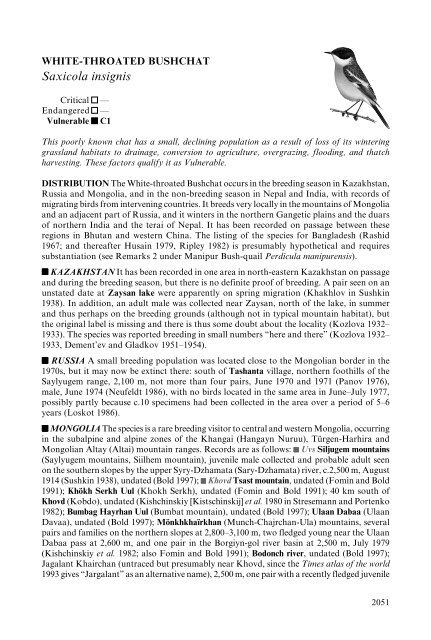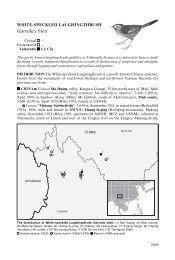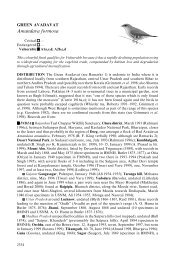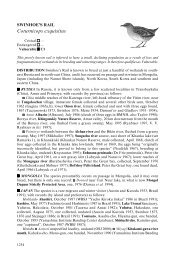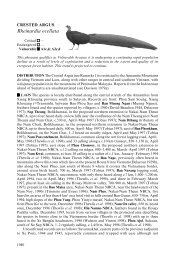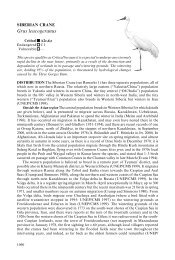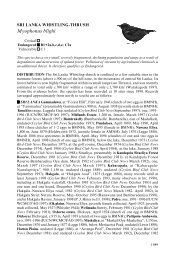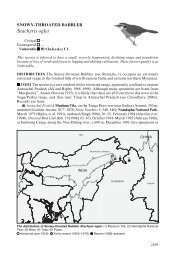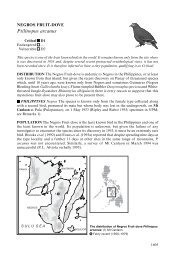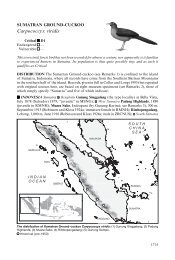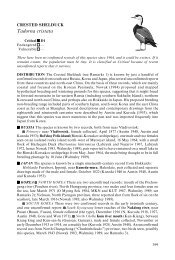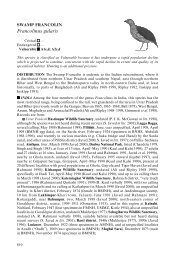Saxicola insignis - BirdBase
Saxicola insignis - BirdBase
Saxicola insignis - BirdBase
Create successful ePaper yourself
Turn your PDF publications into a flip-book with our unique Google optimized e-Paper software.
WHITE-THROATED BUSHCHAT<br />
<strong>Saxicola</strong> <strong>insignis</strong><br />
Critical —<br />
Endangered —<br />
Vulnerable C1<br />
This poorly known chat has a small, declining population as a result of loss of its wintering<br />
grassland habitats to drainage, conversion to agriculture, overgrazing, flooding, and thatch<br />
harvesting. These factors qualify it as Vulnerable.<br />
DISTRIBUTION The White-throated Bushchat occurs in the breeding season in Kazakhstan,<br />
Russia and Mongolia, and in the non-breeding season in Nepal and India, with records of<br />
migrating birds from intervening countries. It breeds very locally in the mountains of Mongolia<br />
and an adjacent part of Russia, and it winters in the northern Gangetic plains and the duars<br />
of northern India and the terai of Nepal. It has been recorded on passage between these<br />
regions in Bhutan and western China. The listing of the species for Bangladesh (Rashid<br />
1967; and thereafter Husain 1979, Ripley 1982) is presumably hypothetical and requires<br />
substantiation (see Remarks 2 under Manipur Bush-quail Perdicula manipurensis).<br />
■ KAZAKHSTAN It has been recorded in one area in north-eastern Kazakhstan on passage<br />
and during the breeding season, but there is no definite proof of breeding. A pair seen on an<br />
unstated date at Zaysan lake were apparently on spring migration (Khakhlov in Sushkin<br />
1938). In addition, an adult male was collected near Zaysan, north of the lake, in summer<br />
and thus perhaps on the breeding grounds (although not in typical mountain habitat), but<br />
the original label is missing and there is thus some doubt about the locality (Kozlova 1932–<br />
1933). The species was reported breeding in small numbers “here and there” (Kozlova 1932–<br />
1933, Dement’ev and Gladkov 1951–1954).<br />
■ RUSSIA A small breeding population was located close to the Mongolian border in the<br />
1970s, but it may now be extinct there: south of Tashanta village, northern foothills of the<br />
Saylyugem range, 2,100 m, not more than four pairs, June 1970 and 1971 (Panov 1976),<br />
male, June 1974 (Neufeldt 1986), with no birds located in the same area in June–July 1977,<br />
possibly partly because c.10 specimens had been collected in the area over a period of 5–6<br />
years (Loskot 1986).<br />
■ MONGOLIA The species is a rare breeding visitor to central and western Mongolia, occurring<br />
in the subalpine and alpine zones of the Khangai (Hangayn Nuruu), Türgen-Harhira and<br />
Mongolian Altay (Altai) mountain ranges. Records are as follows: ■ Uvs Siljugem mountains<br />
(Saylyugem mountains, Siilhem mountain), juvenile male collected and probable adult seen<br />
on the southern slopes by the upper Syry-Dzhamata (Sary-Dzhamata) river, c.2,500 m, August<br />
1914 (Sushkin 1938), undated (Bold 1997); ■ Khovd Tsast mountain, undated (Fomin and Bold<br />
1991); Khökh Serkh Uul (Khokh Serkh), undated (Fomin and Bold 1991); 40 km south of<br />
Khovd (Kobdo), undated (Kishchinskiy [Kistschinskij] et al. 1980 in Stresemann and Portenko<br />
1982); Bumbag Hayrhan Uul (Bumbat mountain), undated (Bold 1997); Ulaan Dabaa (Ulaan<br />
Davaa), undated (Bold 1997); Mönkhkhaïrkhan (Munch-Chajrchan-Ula) mountains, several<br />
pairs and families on the northern slopes at 2,800–3,100 m, two fledged young near the Ulaan<br />
Dabaa pass at 2,600 m, and one pair in the Borgiyn-gol river basin at 2,500 m, July 1979<br />
(Kishchinskiy et al. 1982; also Fomin and Bold 1991); Bodonch river, undated (Bold 1997);<br />
Jagalant Khairchan (untraced but presumably near Khovd, since the Times atlas of the world<br />
1993 gives “Jargalant” as an alternative name), 2,500 m, one pair with a recently fledged juvenile<br />
2051
Threatened birds of Asia<br />
and another male, July 1995, the species possibly being widespread in suitable habitat (which<br />
was not surveyed) on Jagalant Khairchan, Bombat Khairchan (presumably Bumbag Hayrhan)<br />
and in the adjacent Altay (Bräunlich 1995); ■ Dzavkhan near Otgon Tenger Uul (Otgontenger,<br />
Otkhon-tengri snow peak), south-west Khangai mountains, June–July 1929 (four specimens<br />
in MCZ and ZMB; also Fomin and Bold 1991), at Naryn-Gol, south-west of Otgon Tenger<br />
Uul, undated (Kozlova 1932 in Stresemann and Portenko 1982); Dzavkhan river (Zavkhan<br />
river), undated (Fomin and Bold 1991); Khukh Nuur (not mapped; at 47°32’N 98°32’E),<br />
Hangayn Nuruu, 2,600 m, June 1997 (specimen in USNM); ■ Gov’-Altay Khasagt Khaïrkhan<br />
Uul (Khasagtkhairkhan Uul), undated (Fomin and Bold 1991); ■ Arkhangai Chuluut Gol<br />
river, undated (Bold 1997); ■ Bayankhongor Bogdo mountain (Bogd mountain), undated (Bold<br />
1997); Laman-Gegen (Lamen-gegen), east Khangai, upper Tujn-Gol river, one young bird<br />
collected near the monastery, July 1926 (Stresemann and Portenko 1982); Shargaljuut river<br />
(Shargaljuit river), undated (Bold 1997); ■ Övörkhangai Ongiin river, undated (Bold 1997).<br />
■ CHINA The species is a rare passage migrant, recorded in Qinghai, Ningxia and Yunnan,<br />
with records as follows:<br />
■ Qinghai Gyaring Hu lake (Jialing lake), Madoi county, October 1960 (specimen in<br />
ASCN, also Xian Yaohua et al. 1964, Cheng Tso-hsin 1987); Tongchi Gompa (Drechu<br />
Gomba), “Camp 79”, six males, 4,200 m, April–May 1935 (Dolan 1938, Schäfer 1938, Schäfer<br />
and Meyer de Schauensee 1938, also Vaurie 1972, three males in AMNH); “Camp 80”, on<br />
the upper Jalung, within the Kiang steppe, where amongst c.50 birds recorded (presumably<br />
here and at other camps) there was only one female, 4,600 m, April 1935 (Schäfer 1938);<br />
Chindu county, undated (Cheng Tso-hsin 1987);<br />
■ Ningxia Helan Shan mountains (= Ala Shan, Alxa), one young bird collected (which<br />
had already completed its post-juvenile moult), August 1880 (N. M. Przheval’skiy in Kozlova<br />
1932–1933; also Cheng Tso-hsin 1987; see Remarks 1);<br />
■ Yunnan km 47 on the Lijiang-Daju road, April 1988 (S. Jensen per C. R. Robson in litt.<br />
1991).<br />
■ INDIA This species is a winter visitor that has been recorded in the Gangetic plains from<br />
northern Haryana through Uttar Pradesh to Bihar (terai), and in the northern foothills of<br />
northern West Bengal and Assam (duars) (Ali and Ripley 1968–1998, Ripley 1982). Records<br />
are from:<br />
■ Haryana Lalru (“Lallroo”), one, November 1866 (Beavan 1865–1868; but see Remarks<br />
2), and nearby at Ambala, December 1922 (female in BNHS, Jones 1927);<br />
■ Uttar Pradesh Corbett National Park, male, February 1989 (Bose et al. 1989); Gonda,<br />
Avadh (= “Oudh”), one, undated (Stray Feathers 9 [1881]: 505–507), and one male (perhaps<br />
the same), undated (Jesse 1902–1903); Faizabad (Fyzabad), Gorakhpur, December 1878 (male<br />
in BMNH); Captainganj (Kaptanganj), “Zillah Bustee”, October 1878 (Stray Feathers 7 [1878]:<br />
454–455, female in BMNH); Kasia, Gorakhpur, December 1878 (juvenile male in BMNH);<br />
Pipraich (Piprach), Champaran (currently a district of Bihar), December 1878 (male in<br />
BMNH); Kanpur (“Cawnpore”), February, unspecified year (Marshall and Marshall 1875,<br />
Jesse 1902–1903, specimen in BMNH);<br />
■ Bihar Raxaul, on the Nepal border, March 1937 (female in BMNH); Sugauli<br />
(“Segowlee”), two specimens collected, January, unspecified year (Stray Feathers 5 [1877]:<br />
132–133; see Remarks 3); Baghownie, Darbhanga district, December 1902 (Inglis 1901–1904),<br />
March and December 1909 (three specimens in BNHS), January and November 1923 (two<br />
specimens in BMNH); “Rajaputee”, Chupra (Chhapra), Saran district, October–November<br />
1897 (two specimens in BNHS); Patna, November 1937, March 1938, December 1938 (four<br />
specimens in BMNH);<br />
■ West Bengal unspecified locality in the “Lower Hills of Sikkim” (and thus presumably<br />
in present-day West Bengal, but see Remarks 4), a specimen (in BMNH) of an unusually<br />
2052
<strong>Saxicola</strong> <strong>insignis</strong><br />
small male taken by L. Mandelli’s collectors in April 1873; Jalpaiguri, winter visitor, undated<br />
(Inglis et al. 1920), four, January 1931 (two males in BMNH, Inglis 1951–1969);<br />
■ Assam Manas National Park, 1987 (Rahmani et al. 1988), February–April, 1986–1989<br />
(Narayan and Rosalind 1997; also Anon 1990b); Kaziranga National Park, 4–5, April 1995<br />
(Sarma et al. 1997).<br />
In addition, two individuals were thought to be this species, one at Ataria, north of<br />
Lucknow, spring 1897 (Jesse 1902–1903), and another at Motipur, June 1899 (Inglis 1901–<br />
1904), but the identifications were inconclusive.<br />
■ NEPAL Although the species was described from specimens thought to be taken in Nepal<br />
(Jerdon 1862–1864), it transpired that B. H. Hodgson’s specimens came from Bihar just south<br />
of the border with Nepal (Stray Feathers 5 [1875]: 132–133). The species is a scarce and local<br />
winter visitor to the terai region, with records as follows: Royal Sukla Phanta Wildlife Reserve,<br />
fairly common in recent years (Baral and Mills 1992, H. S. Baral in litt. 1996, 1998, Baral<br />
1997b), apparently including about 50, March 1993 (Irvin 1994), up to six, March 1997 (Giri<br />
1997), a maximum of 26, December 1997 (Baral 1998), and three females, January 1999 (J.-C.<br />
RUSSIA<br />
2<br />
KAZAKHSTAN<br />
1<br />
3 4<br />
5<br />
14<br />
6<br />
8<br />
7<br />
12 11<br />
9 13 15 16<br />
18<br />
10<br />
17<br />
MONGOLIA<br />
XINJIANG<br />
INNER MONGOLIA<br />
CHINA<br />
23<br />
QINGHAI<br />
TIBET<br />
19<br />
20 21<br />
22<br />
INDIA<br />
25<br />
HARYANA<br />
26<br />
41<br />
NEPAL<br />
SIKKIM<br />
44 43<br />
UTTAR PRADESH<br />
42<br />
27<br />
33 46<br />
32 45<br />
28 29 3130<br />
34<br />
35 38<br />
36 37<br />
BIHAR<br />
BHUTAN<br />
47<br />
39<br />
ASSAM<br />
40<br />
24<br />
YUNNAN<br />
The distribution of White-throated Bushchat <strong>Saxicola</strong> <strong>insignis</strong>: (1) Zaysan lake; (2) Tashanta; (3) Siljugem<br />
mountains; (4) Tsast mountain; (5) Khökh Serkh Uul; (6) Khovd; (7) Bumbag Hayrhan Uul; (8) Ulaan Dabaa;<br />
(9) Mönkhkhaïrkhan; (10) Bodonch river; (11) Otgon Tenger Uul; (12) Dzavkhan river; (13) Khasagt Khaïrkhan<br />
Uul; (14) Chuluut Gol; (15) Bogdo mountain; (16) Laman-Gegen; (17) Shargaljuut river; (18) Ongiin river;<br />
(19) Gyaring Hu; (20) Tongchi Gompa; (21) Camp 80; (22) Chindu county; (23) Helan Shan; (24) Lijiang-Daju;<br />
(25) Ambala; (26) Corbett National Park; (27) Gonda; (28) Faizabad; (29) Captainganj; (30) Kasia; (31) Pipraich;<br />
(32) Kanpur; (33) Raxaul; (34) Sugauli; (35) Darbhanga district; (36) Chupra; (37) Patna; (38) Jalpaiguri;<br />
(39) Manas National Park; (40) Kaziranga National Park; (41) Royal Sukla Phanta Wildlife Reserve;<br />
(42) Manohara river; (43) Royal Chitwan National Park; (44) Lumbini Sanctuary; (45) Kosi Tappu Wildlife<br />
Reserve; (46) Kosi barrage; (47) Wangdi.<br />
Historical (pre-1950) Fairly recent (1950–1979) Recent (1980–present) Undated<br />
2053
Threatened birds of Asia<br />
Kovacs in litt. 1999); along Manohara river, Kathmandu valley, 1,400 m, two immature males,<br />
October 1982 (Fleming et al. 1984; also Nepali 1986); Royal Chitwan National Park (see<br />
Remarks 5), at Meghauli, 50–100 m, one, March 1986 (Holt et al. 1986), two, April 1991,<br />
and three, January and November 1994 (Drijvers 1995), at Patna, one male, November 1997<br />
(K. Pokharel verbally 1997), 1–2 males, December 1997 (B. Mahato verbally 1997) and north<br />
of Sauraha, just outside Royal Chitwan National Park, one male, December 1997 and January<br />
1998 (K. Pokharel verbally 1998); Lumbini Sanctuary, one male, 1994 (Bird Conservation<br />
Nepal Newsletter 4, 3 [1995]: 2–3), although none, March 1998 (Baral 1998); Kosi Tappu<br />
Wildlife Reserve, one, October 1987 (Heinen 1988), one male, March 2000 (Danphe 9, 1/2<br />
[2000]: 2); Kosi barrage, 50–100 m, unspecified numbers, April 1975 (Fleming et al. 1984), up<br />
to 10, March 1982 (Martins et al. 1983), three, April 1983 (P. Alström, U. Olsson and D.<br />
Zetterström in litt. 2000), three, March 1986 (J. N. Dymond in litt. 1999), one, March 1994<br />
and April 1995 (Bird Conservation Nepal Newsletter 3, 4 [1994] 2, Drijvers 1995), one, March<br />
1996 (Daulne and Goblet 1996), three, March 1996 (Davidson and Heywood 1996), up to<br />
two birds to the south of the barrage, undated (H. Choudhary in litt. 1996); Chisapani (not<br />
mapped), one, August 2000 (Danphe 9 [2000]: 3).<br />
■ BHUTAN There is a single record: Bajothang, 2 km north of Wangdi (Wangdiphodrang),<br />
beside the Sang Chu, one male photographed, April 1999 (B. Carrick and P. Holt in litt.<br />
1999).<br />
POPULATION Although the White-throated Bushchat has always been infrequently<br />
recorded, it is perhaps not as rare as published records indicate, especially as it can be<br />
overlooked amongst congeners (Ali and Ripley 1968–1998). The paucity of recent information<br />
is at least partly explained by the remote and inaccessible nature of its breeding range and<br />
the lack of ornithologists in much of its wintering range. Outside the “Asian” region, the<br />
species has been reported breeding in one small area of Kazakhstan, but any population<br />
there is probably very small (and appears not to have been relocated since the 1930s, so may<br />
no longer even be extant). Until proven otherwise, therefore, the species should be treated as<br />
entirely endemic to the Asian region.<br />
The population data accumulated so far throughout the range of the species suggest that<br />
total numbers might not exceed 1,000 birds. However, as some breeding populations are<br />
fairly dense (see Breeding), and as this species is perhaps likely to be overlooked, the true<br />
figure is here estimated to fall between 2,500 and 10,000 birds. If the results of fieldwork in<br />
the breeding and non-breeding ranges continue to indicate that numbers fall below this level,<br />
the conservation status of the species should be re-assessed (see Remarks 6).<br />
Eastern Russia This species is apparently restricted as a breeding bird to the northern<br />
foothills of the Saylyugem range, close to the north-west Mongolian border, where Panov<br />
(1976) found an isolated population of no more than four pairs in the early 1970s. One bird<br />
was seen there in 1974 (Neufeldt 1986), but the population was considered extinct by 1977 as<br />
none was found in that year (Loskot 1986). The species may be only an irregular breeder in<br />
Russia (M. V. Cherkasova in Ponomareva and Vinokurov 1984), but no recent information<br />
is available and its current status is unclear.<br />
Mongolia A quite large population was discovered in the subalpine zone of the Khangai<br />
mountains in 1929, the species being common on the southern flank of the Otgon Tenger<br />
Uul (Otkhon-Tengri peak) (Kozlova 1932–1933). Very little fieldwork has since been<br />
conducted in the potential breeding range of the species, although Kishchinskiy et al. (1982)<br />
found small numbers including groups of 3–5 pairs with young, and more dispersed solitary<br />
pairs, on the northern macro-slope of the Mönkhkhaïrkhan mountains (part of the Mongolian<br />
Altay range) in July 1979. Several were seen in Khovd province in July 1995, and it was<br />
considered that the species might be widespread in suitable habitat (which was not surveyed)<br />
2054
<strong>Saxicola</strong> <strong>insignis</strong><br />
on Jagalant Khairchan, Bombat Khairchan (presumably Bumbag Hayrhan) and in the<br />
adjacent Altay (Bräunlich 1995).<br />
India In the latter half of the nineteenth century, Hume (1880a) considered the species<br />
“not uncommon along the plains country at the foot of the Himalayas”. In Gorakhpur and<br />
Basti, it occurred “rather sparingly”, with perhaps one pair per 16 km transect of ideal habitat<br />
(see Ecology), a distance in which more than 20 Common Stonechats <strong>Saxicola</strong> torquata would<br />
probably be seen (Stray Feathers 7 [1879]: 519). While clearly a scarce bird, around 10 Whitethroated<br />
Bushchats were shot in these districts in a short period (Stray Feathers 7 [1879]:<br />
519) and this suggests that quite large numbers probably inhabited northern India before the<br />
removal of prime habitat. In the following century, grassland was converted to agricultural<br />
fields or otherwise developed (see Threats under Swamp Francolin Francolinus gularis and<br />
Bengal Florican Houbaropsis bengalensis) and it seems certain that substantial a decline has<br />
occurred. There have been no records, for example, from the Gorakhpur and Basti districts<br />
of Uttar Pradesh since the nineteenth century (see Distribution). Baral (1998c) remarked<br />
that “although it has been recorded from many areas, none of them is known to have a<br />
regular wintering population”, and indeed on the basis of current information the regular<br />
Indian wintering population might be estimated as under 100 birds. This could, however, be<br />
misjudged; in particular, Assam might support higher numbers than is currently known, as<br />
large areas of suitable habitat remain unsurveyed (Baral 1998c). Nevertheless, the species is<br />
scarce and irregular at well watched Kaziranga National Park (Sarma et al. 1997, Choudhury<br />
2000c), while at Manas National Park it appears to be regular in only very small numbers<br />
(Narayan and Rosalind 1997). Furthermore, it was not encountered in almost 10 years of<br />
research in Dudwa National Park, 1980s–1990s (A. R. Rahmani verbally 1998), perhaps one<br />
of the most likely sites for it to occur in Uttar Pradesh.<br />
Nepal The species is a “fairly common winter visitor to Sukla Phanta, but rare elsewhere<br />
in Nepal” (Baral 1998c). It is scarce, for example, at Kosi barrage, with a maximum of 10<br />
birds recorded (Martins et al. 1983), but declining to only one or two birds in the late 1990s<br />
(Baral 1998c), while it has virtually disappeared from Kosi Tappu Wildlife Reserve (Danphe<br />
9, 1/2 [2000]: 2). The population is also rather small at Royal Chitwan National Park, where<br />
only 1–3 birds have been recorded. Baral (1998c) estimated a population of 110 birds in the<br />
country based on site surveys and extrapolation across potential available habitat. A small<br />
population may winter in the grasslands near the Mahakali river, which forms the border<br />
between Nepal and India (Baral 1998c).<br />
ECOLOGY Habitat The White-throated Bushchat breeds very locally in alpine or subalpine<br />
meadows with scattered scrub in the mountains of Mongolia and at a single much drier,<br />
lower location in adjacent Russia (Stresemann and Portenko 1982). At 2,100 m in the northern<br />
foothills of the Saylyugem range (Altay Republic, Russia), the species occupied a hilly, semidesert<br />
plateau with sparse grassy vegetation, scattered low shrubs and outcrops of ancient<br />
rock on the slopes and near the tops of low rounded hills (Panov 1976). Shallow ravines or<br />
gullies with small streams are a further feature of breeding habitat in this area, and nests<br />
were sited low down in the walls of such gullies; the drinking and bathing habits of captive<br />
birds suggested that the species would be unlikely to breed in areas without water (Panov<br />
1976). Favoured habitat in the Khangai mountains in Mongolia is subalpine meadows at<br />
2,430–2,600 m, near streams in areas with many gorges, rocky outcrops and scattered boulders,<br />
birds tending to perch on rocks or on the tops of shrub willow Salix arbuscula and birch<br />
Betula exilis and nesting in rock crevices (Kozlova 1932–1933). In the Mongolian Altay,<br />
breeding birds were similarly found in wet meadows with scree and rocky outcrops, but<br />
higher up, at 2,800–3,100 m (Kishchinskiy et al. 1982).<br />
In winter, the species inhabits extensive patches of dry or moist grasslands, frequenting<br />
the large phantas (open short-grass plains) which once covered much of the Gangetic lowlands<br />
2055
Threatened birds of Asia<br />
but are now largely restricted to a few scattered protected areas in southern Nepal and northern<br />
India (Baral 1998c). In Nepal, it occurs between 75 and 250 m during winter, although it has<br />
been recorded at 1,400 m on passage (Baral et al. 1996). Its wintering habitat has variously<br />
been described as sugarcane fields, “ekra” (= Erianthus ravaneae) grass and other open<br />
grasslands in Bihar (Inglis 1951–1969), “heavy grassland, reeds and tamarisks along riverbeds,<br />
and cane fields” (Ali and Ripley 1968–1998), or “flat, open country thickly dotted with cane<br />
fields” (Stray Feathers 7 [1879]: 519, Oates 1889–1890). It is sometimes found in the reeds at<br />
Kosi barrage and at the edge of fields in the Kathmandu valley (Fleming et al. 1984), and has<br />
been reported frequenting mown grass at a race-course, along with other <strong>Saxicola</strong> species<br />
(Jones 1927). At Manas National Park it occurs on open grasslands composed largely of<br />
Saccharum narenga and Imperata cylindrica, interspersed with tall “elephant grass” and very<br />
few trees (Narayan and Rosalind 1997).<br />
Recent investigations of habitat choice in Nepal (Baral 1998c, from which all information<br />
in this paragraph is taken) suggest some specialisation that is poorly understood. Whitethroated<br />
Bushchat was plentiful in some areas but absent from other apparently identical<br />
sites; within Sukla Phanta Wildlife Reserve, for example, it occurred on the Sukla phanta<br />
itself but not on any other grassland in the area. The grasslands at this site contained many<br />
types of grass with a few trees growing in damper patches and at the grassland periphery.<br />
The species inhabited the open grassland, typically perching on stems 3–5 m high. Birds were<br />
found in both burnt and unburnt grasslands. Prior to burning, they tended to avoid dense<br />
grasslands and occurred only at the edge of dirt roads or small patches of bare ground, this<br />
suggesting a preference for clear areas. After burning, they appeared to prefer burnt to unburnt<br />
patches, especially those with considerable amounts of unburnt tall stems (>1 m) and open<br />
ground; the stems provide perches from which they sally down onto the ground to pick up<br />
their insect prey (see Food). Most sites used by the species were burnt, with 15–75% unburnt<br />
tall grass stems. Optimum habitat thus appears to be a mosaic of disturbed and undisturbed<br />
ground. In Royal Chitwan National Park, they occur in newly formed Saccharum spontaneum<br />
grasslands. Much of this grassland is overgrazed, but parts contain a sufficient quantity of<br />
tall stems to be suitable for this species. The seasonally inundated habitat frequented at Kosi<br />
barrage is dominated by Saccharum spontaneum, sparsely dotted with tamarisk bushes, mostly<br />
below 2 m in height, and bare, sandy ground.<br />
The habits of this bird are generally similar to other <strong>Saxicola</strong> species with which it<br />
sometimes feeds (Jones 1927, Inglis 1951–1969). It is generally solitary and well spaced in the<br />
winter quarters (Stray Feathers 7 [1879]: 519, Ali and Ripley 1968–1998, Fleming et al. 1984),<br />
although some populations can be quite densely packed and locally concentrated: during<br />
extensive observations in Nepal, up to three males were sometimes seen within 2 m of each<br />
other, but a female was only once observed within 5 m of a male (Baral 1998c). In Manas<br />
National Park, India, the species has been reported either singly or in loose pairs in early<br />
spring (Narayan and Rosalind 1997). Although it is reportedly shy and thus difficult to<br />
shoot at times (Dolan 1938, Schäfer and Meyer de Schauensee 1938, Vaurie 1972, Fleming et<br />
al. 1984), it can be approached in Nepal to roughly 10 m on foot and even closer with vehicles<br />
(Baral 1998c; see Food). Other reports from the breeding grounds in Mongolia suggest that<br />
individuals were not at all shy and thus easily shot (Koslova 1930, 1932).<br />
Territoriality in the breeding season appears intense, males in the Saylyugem foothills<br />
vigorously defending small contiguous territories against conspecific intruders (Panov 1976).<br />
Wintering individuals also establish smaller, less defined foraging territories that appear to<br />
be occupied for the whole season (Baral 1998c). Aggressive interactions in winter have been<br />
observed between male White-throated Bushchats, and also interspecifically with male Whitetailed<br />
Stonechat <strong>Saxicola</strong> leucura and Common Stonechat; this trio of species is often observed<br />
in fairly close association because of broad niche overlap (not shared by Grey Bushchat<br />
S. ferrea and Jerdon’s Bushchat S. jerdoni) in the winter quarters (Baral 1998c). Small<br />
2056
<strong>Saxicola</strong> <strong>insignis</strong><br />
territories held by White-throated Bushchats on migration in Manas National Park, India,<br />
are apparently defended against intrusion by Common Stonechat (Narayan and Rosalind<br />
1997).<br />
Food There are no data from the breeding grounds. In winter the diet comprises “insects<br />
(mostly beetles) and their larvae; also some vegetable matter” (Ali and Ripley 1968–1998).<br />
One specimen was found to have “several tenebrionid beetles Gonocephalus elongatum” in its<br />
stomach (BMNH label data). Birds sometimes feed on winged insects and one was observed<br />
capturing a moth in flight (Baral 1998c). Foraging habits (perching on top of bushes or<br />
grasses and descending to the ground for insects) are typical of the genus (Ali and Ripley<br />
1968–1998). A male observed for an hour at Sukla Phanta Wildlife Reserve, Nepal, changed<br />
perches 49 times, of which 11 were lower than 1 m and 38 were taller than 1 m, and dropped<br />
to the ground on eight occasions, remaining perched there for a total of 19 minutes (Baral<br />
1998c). Indeed, the average time spent on the ground is apparently longer than for other<br />
<strong>Saxicola</strong>, with periods of 30 seconds being the norm and often up to a minute; an individual<br />
has even been seen feeding on a ploughed field in a thrush-like manner, “running with its<br />
head lowered close to the ground and raising its head while stationary” (Baral 1998c). In<br />
common with all <strong>Saxicola</strong> species present on the Sukla phanta, individuals often appear to<br />
follow walking observers, or even those riding bicycles (Baral 1998c). Although the reasons<br />
for this behaviour remain obscure, the fact that they follow herds of swamp deer Cervus<br />
duvauceli, suggests that it might relate to increased foraging success when insects are disturbed<br />
and flushed by moving animals (Baral 1998c).<br />
Breeding The species breeds very locally in alpine and subalpine zones (Kozlova 1932–<br />
1933, Dement’ev and Gladkov 1951–1954, Panov 1976, Ali and Ripley 1968–1998). Both sexes<br />
apparently share parental duties (Kozlova 1932–1933). Several pairs usually breed together as<br />
a neighbourhood group, and up to three singing males can be seen and heard from the same<br />
spot (Kozlova 1932–1933, Panov 1976). The distance separating nests in the Saylyugem foothills<br />
in 1970 did not exceed 300 m (Panov 1976). In the Mongolian Altay, 3–5 pairs carrying food<br />
to their fledged young were sometimes only a few tens of metres apart; in other cases, sites<br />
occupied by individual pairs were separated by up to 1–2 km (Kishchinskiy et al. 1982). Breeding<br />
by different pairs is fairly synchronous, well grown nestlings and recently fledged young being<br />
noted in the Saylyugem foothills in late June (Panov 1976), but in the Khangai one late-June<br />
nest contained unincubated eggs, while recently fledged young were seen in late June at another<br />
site (Kozlova 1932–1933). In the Mongolian Altay, one pair was feeding nestlings 15–18 July,<br />
but apparently independent fledglings were also noted at this time (Kishchinskiy et al. 1982).<br />
Four nests found in the Saylyugem foothills were all in holes or crevices in the earth walls of<br />
shallow ravines or gullies, well concealed from above by overhanging grassy turf (Panov 1976);<br />
deep rock crevices are used in Mongolia (Kozlova 1932–1933). The species builds a bulky nest<br />
with thick walls; it is wider at the base than at the top and is composed mainly of dry grass<br />
lined with wool, feathers and dry moss (Panov 1976; also Kozlova 1932–1933). Four to five<br />
eggs are laid and incubation is by the female alone (Kozlova 1932–1933), while both parents<br />
feed the young before and after fledging (Panov 1976).<br />
Migration At Zaysan lake (Kazakhstan), a pair was reported to have occurred on spring<br />
passage (see Distribution). In China (once quite far to the east in Yunnan; see map), the<br />
species has been recorded on spring migration in April–May, and on autumn migration in<br />
October (see Distribution). In spring, it seems to migrate along the Yalung and Yangtze<br />
rivers, stopping here and there for a few days’ rest (Dolan 1938, Schäfer and Meyer de<br />
Schauensee 1938; also Vaurie 1972).<br />
In Nepal and India it usually occurs between October and April, the extreme dates in<br />
India being 27 October and 10 April (Ali and Ripley 1968–1998, Baral 1998c) or, in Assam<br />
in 1986, 24 April (Narayan and Rosalind 1997). Individuals appear at Manas National Park<br />
in India in the spring, sometimes arriving as early as February, sometimes as late as April,<br />
2057
Threatened birds of Asia<br />
and holding small territories for variable periods before moving onward to their breeding<br />
grounds (Narayan and Rosalind 1997). The latest spring record in Nepal is of a male that<br />
remained at Sukla phanta over 3–6 May 1998 (Baral 1998c). Migrating individuals tend to<br />
be observed at higher altitudes as they cross the Himalayas, for instance in the Kathmandu<br />
valley (Baral 1998c) or Bhutan (P. Holt in litt. 1999), and up to 4,600 m in Qinghai, China<br />
(see Distribution). One interesting observation is that, in the late afternoon, all White-throated<br />
Bushchats wintering on the Sukla phanta, Nepal, appeared to move in a south-westerly<br />
direction, entirely vacating the eastern portion of the grassland (Baral 1998c). Although the<br />
function of this movement is unclear, one possibility is that they were attending a communal<br />
roost-site.<br />
In all cases hitherto documented, the population appears to contain a preponderance of<br />
males. On the Sukla phanta, for example, the maximum count of 23 males far outweighs the<br />
corresponding figure of three females (Baral 1998). Other literature suggests that this skewed<br />
sex-ratio is a widespread phenomenon, as females have almost always been encountered or<br />
collected less frequently than males on the wintering grounds (see, e.g., Stray Feathers 5<br />
[1877]: 132–133), and amongst around 50 birds recorded on migration in China, only one<br />
female was counted (Schäfer 1938). This circumstance might arise through some difference<br />
in migratory behaviour between the sexes rather than an actual sex-ratio difference throughout<br />
the population; however, it seems unlikely that females remain on the breeding grounds<br />
throughout the winter, because weather conditions are very harsh. Speculation that they<br />
prefer different habitat types or wintering grounds to the males, or are simply less detectable<br />
because of their behaviour or plumage characteristics, or indeed that they are actually<br />
outnumbered by males, requires clarification through further study.<br />
THREATS Habitat loss and degradation No information is available regarding the state of<br />
the breeding habitat of the species, but it is unlikely to be unduly threatened given the modest<br />
levels of human population density and regional development. Ponomareva and Vinokurov<br />
(1984) indeed reported breeding habitats in Russia to be virtually untouched by human<br />
economic activity.<br />
The destruction and modification of grassland and wetland habitats in its wintering range<br />
is thought to be the main concern (Rahmani 1988b). There have been huge declines in the<br />
area and quality of grasslands in South Asia (Bell and Oliver 1992, Peet et al. 1999a). Virtually<br />
all remaining grasslands within the species’s wintering range are subject to intense pressures<br />
which threaten their future (Rahmani 1988b, 1992c, Javed and Rahmani 1991, Bell and Oliver<br />
1992, Peet et al. 1999a). In many areas grasslands of conservation value are restricted to<br />
protected areas but continue to suffer degradation (Bell and Oliver 1992, Peet 1997), and<br />
grasslands are generally poorly represented in protected-area systems (Rahmani 1988b, 1992c,<br />
Baral 1998c, Buckton et al. 1999).<br />
Habitat loss is the main threat to the species in Nepal, grazing, ploughing and burning<br />
being the primary underlying causes (Baral 1998c). Grassland habitat has disappeared rapidly<br />
in Nepal since 1970, and each year all grasslands within protected areas are cut, burnt and<br />
trampled by more than 100,000 people and their livestock, to say nothing of what happens<br />
to them outside protected areas (Baral 1998c). Intensive grazing or ploughing reduces grass<br />
height below the optimal range for this species, and while burning in moderation can actually<br />
have a positive effect (producing the preferred mosaic of cleared and uncleared areas), it can<br />
also, if not properly managed, eliminate suitable perches (Baral 1998c).<br />
The restricted grassland south of Kosi barrage lies outside protected areas and is highly<br />
disturbed by a large number of local fishermen, cattle-grazing and flood damage, pressures<br />
that are thought to have caused the local decline in the species (Baral 1998c). Flood damage<br />
at Kosi barrage can maintain suitably disturbed grassland habitat, but if too heavy or frequent<br />
it reduces the quality of grassland for this species (Baral 1998c). Nearby, at Kosi Tappu<br />
2058
<strong>Saxicola</strong> <strong>insignis</strong><br />
Wildlife Reserve, the number of people and domestic cattle is steadily increasing, along with<br />
associated disturbance, to the detriment of the environment (D. Petersson 1998). In the west<br />
of the country, tree planting is being encouraged on the open grasslands at Lumbini, with<br />
deleterious effects on habitat suitable for this bird (H. S. Baral in litt. 1998).<br />
More detailed account of threats to grasslands in Nepal and northern India, with reference<br />
to Sukla Phanta Wildlife Reserve and other key sites, appear in the equivalent sections under<br />
Swamp Francolin and Bengal Florican.<br />
MEASURES TAKEN Russia The White-throated Bushchat is included in the Russian Red<br />
Data Book (Kolosov 1983), but no measures have been taken for its conservation<br />
(Ponomareva and Vinokurov 1984).<br />
Mongolia None is known.<br />
India The species occurs irregularly and in small numbers at Kaziranga National Park<br />
and Manas National Park, Assam. It may well be overlooked on other grassland reserves in<br />
the terai of Uttar Pradesh, Bihar, West Bengal and Assam (but see Population).<br />
Nepal Sukla Phanta Wildlife Reserve (155 km 2 , of which almost half is grassland) supports<br />
a small wintering population of the species; there are plans to extend this area to 305 km 2 , an<br />
action that will facilitate the creation of more phantas to the south-west (Baral 1998c). The<br />
species also occurs in smaller numbers in Royal Chitwan National Park (932 km 2 ) of which<br />
around 21% is grassland, grass-jungle or riverine forest (Baral 1998c). Grasslands at Patna<br />
have recently developed following the evacuation of a village in the park, an action that has<br />
led to the emergence of additional habitat for the species, at least temporarily (Baral 1998c).<br />
It also winters irregularly in Kosi Tappu Wildlife Reserve (175 km 2 ), an area subject to<br />
annual flooding and 70% of which is grassland (Baral 1998c). A crane sanctuary has been<br />
established at Lumbini, with possible benefits to suitable grassland habitat (Baral 1998c).<br />
MEASURES PROPOSED The conservation requirements of the White-throated Bushchat<br />
should be viewed in combination with the needs of a variety of other threatened grassland<br />
birds within its range so that a programme of habitat management and research can be<br />
implemented with benefits to each of these species (see Measures Proposed under Bengal<br />
Florican).<br />
Legal protection A recommendation has been forwarded to the government of Nepal to<br />
confer full legal protection to the species under the National Parks and Conservation Act<br />
(Baral 1998c). It should also be given the highest category of protection in China (Liu Naifa<br />
in litt. 1997) and India.<br />
Protected areas and grassland management In eastern Russia (and other Central Asian<br />
countries that were formerly part of the USSR), Ponomareva and Vinokurov (1984) proposed<br />
that surveys should be undertaken to find out where the species is breeding and that<br />
“zakazniks” (seasonal reserves or sanctuaries) be established for the protection of the whole<br />
complex of montane-steppe species.<br />
In the wintering range, the protection and management of grasslands is the main<br />
conservation focus for this and several others species (see Remarks 7 under Bengal Florican).<br />
Even highly grazed open areas quickly regenerate into high-quality grassland habitat if<br />
properly protected and managed; in Nepal, they are naturally and quickly colonised by either<br />
Saccharum spontaneum or Imperata cylindrica grasses and this bushchat uses the habitat<br />
within one or two years (Baral 1998c, 2000a). For this reason, proposed extensions to protected<br />
areas should include as much potential grassland as possible, even if the habitat does not<br />
immediately appear suitable for threatened species.<br />
Kosi Tappu Wildlife Reserve should be considered for expansion and proper management<br />
to maximise and protect suitable habitat. In addition, open areas to the east of Sukla Phanta<br />
Wildlife Reserve near Radhapur and Jhilmila could be converted to grassland areas of<br />
2059
Threatened birds of Asia<br />
outstanding importance for birds and mammals; some of this area is apparently already<br />
within reserve boundaries and requires management or an integrated community project to<br />
re-establish high-quality grassland and swampland habitat with value to local people and<br />
wildlife (Baral 1998c).<br />
General grassland-management recommendations for India and Nepal are made under<br />
Bengal Florican and Swamp Francolin; it should be noted that the preference of this species<br />
for some open areas means that a rotational clearance regime at key sites is required so that<br />
suitable habitat is made available. Although small amounts of habitat disturbance (burning<br />
and clearing) are of benefit to this species as it provides areas of open ground suitable for<br />
foraging, the activities of people on grasslands within protected areas require monitoring<br />
and control (Baral 1998c).<br />
Education A programme of talks, posters, audio-visual presentations and field outings<br />
should lay the foundations for public awareness of conservation problems and possibilities<br />
in grasslands of the terai and duars of India and Nepal (Baral 1998c, Choudhury 2000c).<br />
Research As so little is known of its distribution and population in the breeding season,<br />
fieldwork in Kazakhstan, Mongolia and adjacent Russia should focus clarifying these issues<br />
and identifying any threats. An intensive survey of the Gangetic plains during winter, focusing<br />
on all potential natural grassland areas, is required to identify further key sites for the species;<br />
if any wintering populations are found in India they should receive immediate conservation<br />
action. Ringing and colour-banding surveys would provide useful information regarding<br />
movement and site-fidelity of individuals. Grasslands in the south-west portion of Rupandehi<br />
district, Nepal, on the border with Kapilvastu district, deserve exploration for populations<br />
of this species, as do the grasslands along the Mahakali river (Baral 1998c). Further study<br />
into micro-habitat requirements is required, especially given the fact that the species appears<br />
to favour some grasslands in winter while remaining absent from apparently identical areas;<br />
an investigation of the characteristics of occupied and unoccupied sites may shed some light<br />
on the precise requirements of the species (Baral 1998c). A long-term study is required to<br />
determine the effect of grassland management on its populations.<br />
REMARKS (1) Although several first-winter birds were reportedly collected by Przheval’skiy<br />
in the Helan Shan mountains (Ningxia) in August–September 1880 (Stresemann and Portenko<br />
1982), the subadult male from August 1880 was apparently the only specimen collected (R.<br />
L. Potapov per M. Wilson in litt. 2001). (2) As noted by Whistler (1918), the record from<br />
Lalroo is described at length by Beavan (1865–1868) but then omitted by Baker (1922–1930),<br />
suggesting either an oversight or a withdrawn record. (3) Although these specimens (including<br />
the type) were first listed as taken in Nepal (Gray and Gray 1846, Blyth 1847), A. O. Hume<br />
(Stray Feathers 5 [1877]: 132–133) pointed out that they were in fact taken “some 16 miles<br />
south of the Nepal frontier and on the main road to Khatmandoo”. (4) As this record is<br />
presumably that referred to as “Bhutan duars” (a term denoting foothills in West Bengal<br />
west of the Tista river and in eastern Assam bordering Bhutan), in April of an unspecified<br />
year (Stray Feathers 5 [1877]: 495–502, Hume 1880a, Oates 1889–1890; also Inglis 1951–<br />
1969), this latter locality is not mapped. (5) A record of a single bird in Royal Chitwan<br />
National Park, at Narayani river, December 1994 (Smith et al. 1996), was considered<br />
provisional by Baral (1998c). (6) Baral (1998c) suggested that the status of the White-throated<br />
Bushchat should be revised to Endangered.<br />
2060


